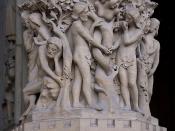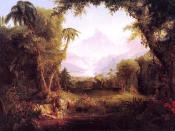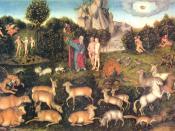Candide by Voltaire is a novel that satirizes different aspects of medieval ideas, theories and generally the way of life. The Garden of Eden is used as a structuring device to show how people used to live in paradise and lost it buy trying to find an even better place. The plot takes place in the eighteenth century, on three different continents: Europe, South America and Asia. The main characters live in a beautiful castle which they loose by wanting to find a better place. Candide, the protagonist of the story, is a naive and irrational young man who keeps on loosing his perfect paradise for foolish reasons and ends up with only an illusion of the Garden of Eden. There are three main gardens in the book; the castle in Westphalia, Eldorado, and a garden at the end of the book. All of these gardens have a small part of paradise, but leaving them causes pain and suffering.
In fact, the similarities to the Garden of Eden decrease after each lose of these gardens.
The first garden is connected to the Garden of Eden in many different ways. Firstly it is a garden where the story starts; it belongs to a beautiful castle with doors and windows. This is like the Garden of Eden because it was a place where the beginning of humanity began whereas; here it is the beginning of CandideÃÂs adventure. The second part relates to the Garden of Eden is when Cunégonde sees Pangloss and Paquette having sex. She also has a desire to try it with Candide. This connects to EveÃÂs desire to understand the difference between god and evil. Eve also wants to share this knowledge with Adam. That leads to the third part where Candide is kicked out from the castle,


